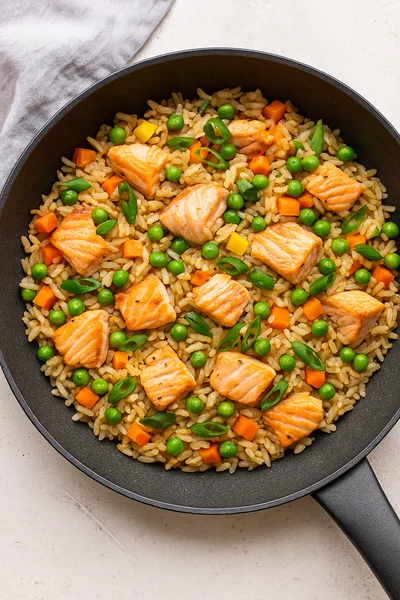Leftover Salmon Fried Rice

Turn leftover fish into a satisfying fried rice loaded with vegetables and savoury flavour. This is the ultimate way to transform yesterday's salmon into a restaurant-quality meal that's packed with umami, texture, and nutrition. The high heat of the wok creates that signature smoky flavour while the cold rice ensures perfectly separated grains that won't turn mushy.
Ingredients
- 2 tablespoons soy sauce
- 1 teaspoon brown sugar
- 1 tablespoon vegetable oil
- 1 small onion, diced
- 1 bell pepper, diced
- 2 cloves garlic, minced
- 1 teaspoon grated fresh ginger
- 2 large eggs, lightly beaten
- 3 cups cooked rice (preferably cold)
- 1 cup frozen peas
- 1 cup flaked cooked salmon
- 2 green onions, sliced
- 2 tablespoons chopped cilantro
Instructions
- Stir together the soy sauce and brown sugar in a small bowl; set aside.
- Heat oil in a large skillet or wok over medium‑high heat. Add onion and bell pepper; sauté until softened.
- Add garlic and ginger and cook until fragrant, about 30 seconds.
- Push the vegetables to one side and pour in the beaten eggs. Scramble until just set.
- Add the rice and peas; toss everything together and cook for 2 minutes.
- Stir in the flaked salmon and pour over the soy sauce mixture. Cook until heated through.
- Remove from heat and garnish with green onions and cilantro.
Equipment Needed
- Large wok or skillet (12-inch or larger)
- Wooden spoon or wok spatula
- Small mixing bowl
- Whisk or fork
- Chef's knife and cutting board
Tips & Variations
- Day-old rice is key: Using cold, day-old rice prevents the fried rice from becoming mushy and helps achieve that perfect texture. Freshly cooked rice has too much moisture.
- High heat technique: Keep your wok or skillet over high heat throughout cooking to develop that signature smoky "wok hei" flavour.
- Scramble separately: Push vegetables to the side before adding eggs to ensure they cook evenly without getting mixed into the rice too early.
- Add extras: Try adding shrimp, diced chicken, or tofu along with the salmon for extra protein and variety.
- Spice it up: Add sriracha, chili oil, or red pepper flakes for heat, or finish with a drizzle of sesame oil for extra aroma.
- Vegetable variations: Swap in broccoli, snap peas, carrots, or corn based on what you have in your fridge.
Nutritional Information
Per serving (1/4 of recipe):
- Calories: 385
- Protein: 22g
- Fat: 12g (Saturated: 2.5g)
- Carbohydrates: 48g
- Fiber: 3g
- Omega-3 Fatty Acids: 1.4g
- Sodium: 680mg
- Sugar: 4g
A balanced meal with protein from salmon and eggs, complex carbs from rice, and vitamins from vegetables. Perfect for using leftover salmon while maintaining nutritional value.
Storage & Reheating
Refrigerator: Store in an airtight container for up to 3 days. The fried rice actually tastes even better the next day as the flavours meld together.
Freezer: Freeze individual portions in freezer-safe containers for up to 2 months. This makes an excellent meal prep option.
Reheating: Reheat in a hot wok or skillet with a splash of oil for best results. You can also microwave for 2-3 minutes, stirring halfway through, but the wok method restores the best texture.
Meal prep tip: Cook a large batch on Sunday and portion into containers with vegetables for easy grab-and-go lunches throughout the week.
Serving Suggestions
Pair your leftover salmon fried rice with:
- Asian appetizers: Spring rolls, edamame, or gyoza dumplings
- Soups: Miso soup, egg drop soup, or hot and sour soup
- Salads: Asian cucumber salad, seaweed salad, or Chinese chicken salad
- Condiments: Soy sauce, sriracha, chili oil, or sweet chili sauce
- Garnishes: Extra green onions, sesame seeds, crispy wonton strips, or fried shallots
Recipe Notes
Rice preparation: If you don't have day-old rice, spread freshly cooked rice on a baking sheet and refrigerate for 30 minutes to remove excess moisture.
Salmon handling: Gently fold in the salmon at the end to prevent it from breaking into too-small pieces. Large flakes are more appealing.
Soy sauce substitute: Use tamari for gluten-free, coconut aminos for lower sodium, or liquid aminos for a different flavour profile.
Wok technique: If you don't have a wok, use the largest skillet you have and cook in two batches if necessary to avoid overcrowding.
Timing matters: Add ingredients in stages (aromatics first, then vegetables, then rice) to ensure everything cooks properly without overcooking.
Flavor boost: A teaspoon of fish sauce or oyster sauce added with the soy sauce creates deeper umami flavour.